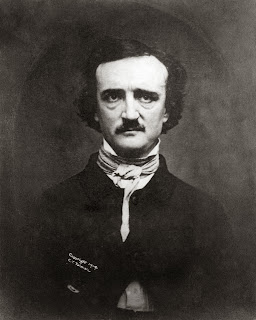Narrator in The Tell Tale Heart
 |
| The Great Edgar Allan Poe |
One of the best examples of an unreliable narrator, the narrator
in “The Tell Tale Heart” can also be classified as a
participant narrator based on his first-hand account of events in the story.
Evidence of his first-hand account can be found in the use of the word
"I" as well as his vivid description of the murder he committed. He
also proves himself to be an unreliable narrator when he fails to distinguish
between his imagination and reality. He fails to realize that the beating heart
he hears, is actually inside his head, and wasn't actually happening.
The
combination of a participant narrator that is also unreliable is intentional. The
story is best told from his point of view, because the depth of his madness
would have been lost had it been told from anyone else’s. This narrative style
causes the reader to be more amazed at the mental roller coaster that is the
narrator, than the actual murder. The reader is left more amazed at the how
detailed he was in the execution of his plan, than the actual plan itself. The narrator reducing the old man’s identity
to an eye ensures that very little emotional affiliation is attached to the Old
Man, instead causing you to examine his insanity.
The narrative style in “The Tell Tale Heart” is also aided by the
sentence construction (syntax). Longer sentences are used when he speaks of the murder as
well as the events leading up to it, and shorter sentences when he speaks of
his motive as well as when he speaks to the police. Many pauses are inserted in the longer sentences in the form of
comas, hyphens and semicolons, and his descriptions are often aided by
exclamation marks. This causes the reader to experience every high and low of the
narrator's mind, as well as the rush associated with his insanity. By the end of the
story, the reader feels as if they had just escaped the mental abyss that is
his mind.

No comments:
Post a Comment